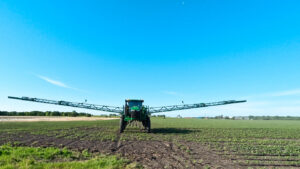The government shutdown has left growers without access to important crop data published monthly by the USDA. The federal agency is responsible for publishing the monthly World Agriculture Supply and Demand Estimates (WASDE) report, a comprehensive forecast of crop and livestock supply and demand. Insights from this report are fundamental to informing the global agricultural market, which guides growers’ decision-making. The January edition was due today, but the shutdown has put the report on hold indefinitely.
Regularly published trade estimates, or market polls, only cover small portions of the WASDE, both in terms of numbers of crops and variables forecasted. They are impossible to confirm because industry analysts do not provide their individual methodologies.
To address the lack of intel, three ag data startups are providing public access to their data to keep growers afloat: plant microbiome startup Indigo Ag, organic and non-GMO data company Mercaris, and machine learning and AI data startup Gro Intelligence.
Indigo Ag
Indigo Ag is sharing agricultural market data for the Americas gathered by its GeoInnovation unit, formerly known as TellusLabs, which predicts yields. The company claims that its technology has outperformed the USDA in recent years.
“Informed market perspectives are fundamental to a grower’s profitability,” said David Perry, Indigo’s CEO, in a press release announcing open access to its data. “With access to the right data, a grower decides which inputs to buy, crops to plant, dates to sell, and more – decisions that will affect the rest of his or her season. As a company that wants to support growers’ independence, Indigo is providing this access to streamlined insights, especially since they are otherwise unavailable.”
“The absence of the January 11th government yield estimates makes data-driven private forecasts more compelling than ever,” said Benjamin Riensche, an Iowa-based grower and advisory board member of Indigo Research Partners, in the same press release. “Even better, this data is virtually real-time, rather than the weeks’ old data in government reports. It can accurately reflect a quickly evolving situation in Brazil, which appears to be experiencing a shrinking crop in recent dry weather. Here in the US, Indigo’s analytics seem more likely to pick up on soybean yield and quality reductions from wet harvest conditions in North Central and Northeast Iowa, as well as refute the old conventional logic that ‘rain makes grain’ for this prime production area.”
Mercaris
Mercaris, which claims to be the only source of market data for organic and non-GMO prices, has also offered its bi-weekly Organic Grains Report to producers for free. The company dedicated its first 2019 market update to the organic commodity import data that would otherwise be available from the USDA. Mercaris estimates that U.S. buyers imported a total of 2,200 MT of organic corn in November 2018 and 2,300 MT in December 2018.
“As 2019 begins it will be crucial to watch how trade develops, if imports are able to find their footing and recover, or if they will continue to slowly shrink away,” said Kellee James, co-founder and CEO at Mercaris. “Established and verified sources of government data will certainly play a critical role in monitoring these developments. However, until the shutdown ends, Mercaris will continue to fill in the gap with market insights and estimates.”
Gro Intelligence
Gro Intelligence has released its report on supply and demand forecasts for agricultural crops worldwide to help fill the void left by the delay the USDA’s WASDE report. Gro has been offering free subscriptions to its web app since shortly after the government shutdown began on December 22. It claims to have the world’s most comprehensive agricultural data platforms and makes forecasts for corn, wheat, and soybean demand. With data updates from the US government on hold, the Gro estimates will analyze country/crop pairings using five distinct methodologies for both supply and demand. It will also estimate production for other crops such as cotton, rice, and sugar. In all, Gro will be releasing over 1,000 forecast models covering 35 crops grown around the world.
Farmers Also Lack Access to Financial Services Including Crop Support Payments
There are countless programs within the federal government that farmers rely on including, crop support payments. Last week, the federal government issued a statement indicating that support payments would continue to be issued during the shutdown. But payments for producers who have not completed certain steps of the process like certifying their production their checks won’t be hitting their mailboxes anytime soon.
The USDA has allocated over $9 billion in direct payments for soybean, corn, wheat, and sorghum growers affected by current tariffs resulting from the Trump Administration’s trade wars abroad. The first round of payments was issued mid-September and the deadline to sign up to be included in the second round of payments is January 15. Senators from strong agricultural states like Sen. Charles E. Grassley (R-Iowa) have asked the administration to extend this deadline so that farmers can certify their crop production and obtain a bailout amid shutdown delays.
Other legislators note that many farmers are unable to take advantage of new support programs in the recently enacted farm bill.
A number of financial assistance programs have also been affected by the shutdown, including Farm Service Agency which offers operating loans and microfinancing. In 2018, direct and guaranteed FSA operating loans reached almost $2.2 billion.
“If they have even a disaster loan, they have bought posts and fences to fix after the fires, and now the bills are due but there’s no payment to access. So it’s a difficult time and it’s happening during a depressed market economy,” Terry Detrick, president of the Oklahoma Farmers Union recently told The Progressive Farmer.
Combined with the fact that net farm income for 2018 was 47% lower than 2013 and 12% lower than 2017, many farmers are feeling a financial pinch during the shutdown as well as a lack of access to data.
If the shutdown persists, other federal programs that farmers use may also face a furlough.
Farmers may find other open access data resources during the shutdown. In October 2018, precision ag startup OneSoil released its OneSoil Map database to the public. The map allows users to see how fields have changed over prior years and includes information on fields and crops in 43 countries.
Know of any other startups offering free services to farmers during the shutdown? Get in touch: [email protected]




